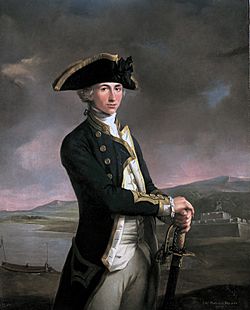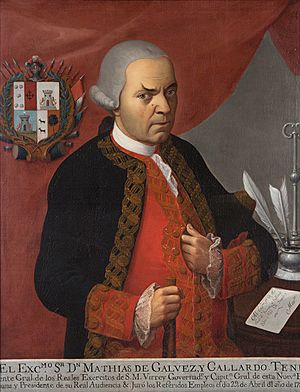San Juan Expedition (1780) facts for kids
Quick facts for kids San Juan Expedition |
|||||||
|---|---|---|---|---|---|---|---|
| Part of the American Revolutionary War | |||||||
 Captain Horatio Nelson, painted by John Francis Rigaud in 1781, with Fort San Juan in the background. |
|||||||
|
|||||||
| Belligerents | |||||||
| Commanders and leaders | |||||||
| Matías de Gálvez Juan de Ayssa |
John Polson † Horatio Nelson |
||||||
| Strength | |||||||
| 160 regulars & militia (Fort San Juan) 500 militia (Granada's outskirts) |
3,000 regulars, militia, Criminals & sailors 1 frigate 2 brigs 3 sloops 1 tender 1 transport |
||||||
| Casualties and losses | |||||||
| unknown killed or wounded 45 captured |
2,500 killed or died of disease 2 ships grounded |
||||||
The San Juan Expedition was a military operation that happened between March and November 1780. It was part of the American War of Independence. A British force, led by John Polson and Captain Horatio Nelson, landed in what is now Nicaragua.
Their goal was to sail up the San Juan River. They wanted to capture important towns like Granada and León. These towns were located near Lake Nicaragua.
Even though the British first captured the Fortress of the Immaculate Conception, they never reached Lake Nicaragua. Many soldiers became very sick with yellow fever. The British force had to return to Jamaica. This campaign was a complete failure. It caused the deaths of over 2,500 British soldiers. This made it the most costly British disaster of the entire war.
Contents
Why Did the Expedition Happen?
Spain Joins the War
Spain joined the American Revolutionary War in 1779. After this, Major-General John Dalling had an idea. He was the governor of Jamaica. He suggested a military trip against the Spanish area of Nicaragua.
At that time, Nicaragua was part of the Captaincy General of Guatemala. This was a region controlled by Spain.
British Goals in Nicaragua
The main goal of the expedition was to capture the town of Granada. If they captured Granada, it would split Spanish America in half. This would also give Great Britain a way to reach the Pacific Ocean. People even imagined that "the flags of England were already on the walls of Lima," a major city in South America.
How the Expedition Unfolded
Setting Sail from Jamaica
The expedition started from Jamaica on February 3, 1780. It included several ships. There was a transport ship called Penelope. There were also two brigs, three sloops, and a small supply ship called the Royal George.
Twenty-one-year-old Captain Horatio Nelson escorted them. He was on his ship, the 28-gun HMS Hinchinbrook. Nelson was the highest-ranking naval officer. However, he was only in charge of the ships.
Who Led the Troops?
Captain John Polson was the overall commander. He had about 3,000 men under his command. These included 100 soldiers from the 60th Royal American Regiment. There were also 140 men from the 79th Liverpool Blues.
Other groups included 240 Royal Jamaica Volunteers and 250 members of the Jamaica Legion. There were also 125 men from the Royal Batteaux Corps. Many black volunteers also joined the force.

Moving Up the River
The expedition faced delays. They waited for Miskito Indian bowmen, but they never arrived. On March 24, the ships finally anchored near San Juan del Norte. Three days later, Polson's troops got into boats. They moved up the river in two groups.
On April 9, Nelson led an attack. This was his first hand-to-hand combat. They captured a small Spanish fort on Bartola Island.
The Siege of Fort San Juan
About five miles (8 km) upstream was Fort San Juan. It had about 160 defenders, but only 60 were soldiers. The British began to surround the fort on April 13.
However, the British had problems. Their planning was poor, and supplies were lost. They soon started to run out of ammunition for their cannons. They also ran low on food for the men.
Sickness and Retreat
Tropical rains began on April 20. Soon, soldiers started to get sick and die. They likely suffered from malaria and dysentery. Some might have had typhoid fever. Nelson himself became ill on April 28. He was sent downriver.
The next day, the Spanish defenders at the fort surrendered. They were led by Juan de Ayssa. They had run out of ammunition, food, and water.
The British troops could not advance further. Even with 450 new British soldiers arriving on May 15, they stayed at the fort for six months. During this time, hundreds of them died from sickness. Meanwhile, the Spanish leader, Viceroy Matías de Gálvez, made the entrance to Lake Nicaragua stronger.
Sickness continued to harm the British troops. The order to leave was given on November 30.
What Happened Next?
Spanish Regain Control
The British blew up the fort when they left. The Spanish then took back the remains of the fort.
Even though Don Juan de Ayssa had surrendered the fort, he was promoted. He became a lieutenant colonel. This was recorded in a Royal Order on June 12, 1781. He had warned other Spanish forts in the area. He bravely defended Fort San Juan. He also suffered as a prisoner of war. He greatly helped make things difficult for the British.
He was taken prisoner to Jamaica. He was freed when the war ended. In 1783, he became the governor of Nicaragua.
Images for kids
See also
 In Spanish: Expedición a San Juan para niños
In Spanish: Expedición a San Juan para niños



